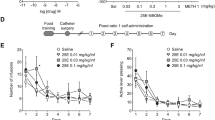Summary
The dopamine D3 preferring ligand R-(+)-7-OH-DPAT induced strong hypolocomotion in rats. Doses producing reduction of locomotion failed to affect dopamine release or synthesis rate. These data support the hypothesis that the dopamine D3 receptor is a postsynaptic receptor with an inhibitory influence on rat locomotor activity.
Similar content being viewed by others
References
Daly SA, Waddington JL (1993) Behavioural effects of the putative D-3 dopamine receptor agonist 7-OH-DPAT in relation to other “D-2-like” agonists. Neuropharmacology 32: 509–510
Damsma G, Bottema T, Westerink BHC, Tepper PG, Dijkstra D, Pugsley TA, MacKenzie RG, Heffner TG, Wikström H (1993) Pharmacological aspects of R-(+)-7-OH-DPAT, a putative dopamine D3 ligand. Eur J Pharmacol 249: R9-R10
Sokoloff P, Giros B, Martres MP, Bouthenet ML, Schwartz JC (1990) Molecular cloning and characterization of a novel dopamine receptor (D3) as a target for neuroleptics. Nature 347: 146–151
Ståhle L (1992) Do autoreceptors mediate dopamine agonist—induced yawning and suppression of exploration? A critical review. Psychopharmacology 106(1): 1–13
Tallarida RJ, Murray RB (1984) Manual of pharmacologic calculations with computer programs. Springer, New York, pp 59–63
Waters N, Svensson K, Haadsma-Svensson SR, Smith MW, Carlsson A (1993a) The dopamine D3-receptor: a postsynaptic receptor inhibitory on rat locomotor activity. J Neural Transm [GenSect] 94: 11–19
Waters N, Lagerkvist S, Löfberg L, Piercey MF, Carlsson A (1993b) The dopamine D3 receptor and autoreceptor preferring antagonists (+)-AJ76 and (+)-UH232; a microdialysis study. Eur J Pharmacol 242: 151–163
Wikström H, Andersson B, Sanchez D, Lindberg P, Arvidsson LE, Johansson AM, Nilsson JLG, Svensson K, Hjorth S, Carlsson A (1985) Resolved monophenolic 2-aminote-tralins and 1,2,3,4,4a,5,6,10b-octahydrobenzo[f]quinolines: structural and stereochemical considerations for centrally acting pre-and postsynaptic dopamine-receptor agonists. J Med Chem 28: 215–225
Author information
Authors and Affiliations
Rights and permissions
About this article
Cite this article
Svensson, K., Carlsson, A. & Waters, N. Locomotor inhibition by the D3 ligand R-(+)-7-OH-DPAT is independent of changes in dopamine release. J. Neural Transmission 95, 71–74 (1994). https://doi.org/10.1007/BF01283032
Received:
Accepted:
Issue Date:
DOI: https://doi.org/10.1007/BF01283032




